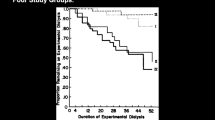Abstract
The BioStat 1000 is a new device which employs dialysate-based urea kinetics to calculate the dose of dialysis (Kt/V) based on a two-pool model and protein catabolic rate (PCR). Previous methods relying on blood sampling techniques were subject to error and difficult to implement. This paper describes the features of the Biostat and the results of the first clinical validation study with an early prototype. The BioStat was found to compare favorably with the reference method of direct dialysate quantification (mDDQ) which had been modified to obtain a “two-pool” Kt/V. In 31 patients no significant difference was found between mean Kt/V from the mDDQ and the mean Kt/V from the BioStat (1.35±0.33 versus 1.38±0.36, respectively). The PCR was also not significantly different (53.4±18.5 g/day versus 51.8±16 g/day, respectively). The BioStat was demonstrated to be a convenient method producing reliable results.
Similar content being viewed by others
References
Farrell PC (1988) Dialysis kinetics. ASAIO Primers in Artificial Organs 4: 1–30
Depner TA (1991) Prescribing hemodialysis: a guide to urea modeling, 1st edn. Kluwer, Boston
Gotch F (1990) Kinetic modeling in hemodialysis. In: Nissenson A, Fine R, Gentile D (eds) Clinical dialysis, 2nd edn. Appleton and Lange, Norwalk, pp 118–146
Sargent JA, Gotch FA (1989) Principles and biophysics of dialysis. In: Maher J (ed) Replacement of renal function by dialysis, 3rd edn. Kluwer, Dordrecht, pp 87–143
Ilstrup K, Hanson G, Shapiro W, Keshaviah P (1985) Examining the foundations of urea kinetics. Trans Am Soc Artif Intern Organs 31: 164–168
Daugirdas JT (1993) Second generation logarithmic estimates of single-pool variable volume Kt/V: an analysis of Error. J Am Soc Nephrol 4: 1205–1213
Barth R (1988) Direct calculation of KT/V: a simplified approach to monitoring of hemodialysis. Nephron 50: 191–195
Frost T, Kerr D (1977) Kinetics of hemodialysis: a theoretical study of the removal of solutes in chronic renal failure compared to normal health. Kidney Int 12: 41–50
Delmez JA, Windus DW (1992) Hemodialysis prescription and delivery in a metropolitan community. The St. Louis Nephrology Study Group. Kidney Int 41: 1023–1028
Held P, Levin N, Bovbjerg R, Pauly MV, Diamond LH (1991) Mortality and duration of hemodialysis treatment. JAMA 265: 871–875
Gotch F, Yarian S, Keen M (1990) A kinetic survey of US hemodialysis prescriptions. Am J Kidney Dis 15: 511–515
Sargent J (1990) Shortfalls in the delivery of dialysis. Am J Kidney Dis 15: 500–510
Lowrie E, Teehan B (1983) Principles of prescribing dialysis therapy: implementing recommendations from the NCDS. Kidney Int 23: S113-S122
Lowrie E, Laird N, Parker T, Sargent JA (1981) Effect of the hemodialysis prescription on patient morbidity. N Engl J Med 305: 1176–1181
Held P, Brunner F, Odaka M, Garcia JR, Port FK, Gaylin DS (1990) Five year survival for end-stage renal disease patients in the United States, Europe and Japan, 1982–1987. Am J Kidney Dis 15: 451–457
Hull A, Parker T (1990) Introduction and summary: Proceedings from the Morbidity, Mortality and Prescription of Dialysis Symposium, Dallas, Texas, 15–17 September, 1989. Am J Kidney Dis 15: 375–383
Bosticardo G, Alloatti S, Avalle U, et al. (1993) Single-pool urea kinetic model (UKM) and simplified formulas: comparison of results (abstract) J Am Soc Nephrol 4: 335
Borah MF, Schoenfeld PY, Gotch FA, Sargent JA, Wolfsen M, Humphreys MH (1978) Nitrogen balance during intermittent dialysis therapy of uremia. Kidney Int 14: 491–500
Keshaviah P, Star R (1994) A new approach to dialysis quantification: an adequacy index based on solute removal. Semin Dial 7: 85–90
Gotch F, Sargent J (1985) A mechanistic analysis of the National Cooperative Dialysis Study (NCDS). Kidney Int 28: 526–534
Malchesky P, Ellis P, Nosse C, et al. (1982) Direct quantification of dialysis. Dial Transplant 11: 42–49
Lin L (1989) A concordance correlation coefficient to evaluate reproducibility. Biometrics 45: 255–268
Depner T (1994) Assessing adequacy of hemodialysis: urea modeling. Kidney Int 45: 1522–1535
Author information
Authors and Affiliations
Rights and permissions
About this article
Cite this article
Keshaviah, P.R., Ebben, J.P. & Emerson, P.F. On-line monitoring of the delivery of the hemodialysis prescription. Pediatr Nephrol 9 (Suppl 1), S2–S8 (1995). https://doi.org/10.1007/BF00867675
Received:
Accepted:
Issue Date:
DOI: https://doi.org/10.1007/BF00867675




